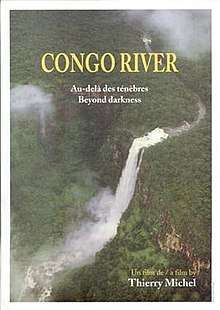Congo River, Beyond Darkness
Congo River, beyond darkness is a 2005 film by Thierry Michel examining the Congo River in Africa.
| Congo River, beyond darkness | |
|---|---|
 | |
| Directed by | Thierry Michel |
| Written by | Thierry Michel |
| Music by | Lokua Kanza |
Release date | 2005 |
| Country | Belgium |
| Language | French English |
Synopsis
The film takes us from the mouth to the source of the second largest river basin in the world, that of the Congo River (the largest is the Amazon). All along its 4371 km, we discover places that have seen the turbulent history of this country, while archives remind us of the mythological figures that created its destiny: explorers such as Livingstone and Stanley, the colonial kings Leopold II and Baudouin and leaders such as Lumumba, Mobutu and Kabila.
Technical data
The collector's edition DVD of "Congo River" (2 DVD) with:
- The making of (52 min.)
- Interview of Thierry Michel
- Trailer
- Versions: French and English with subtitles in French, Dutch, German and English
The DVD of "Congo River" with:
- Versions: French and English with subtitles in French, Dutch, English and German
The serial:
- Number: 3 episodes
- Length: 2h30
- Versions: French and English
gollark: μhahahahaha.
gollark: Sure.
gollark: At least you can still probably get IRC on port 6697.
gollark: That seems worryingly plausible.
gollark: I'm pretty sure I remember there being some vulnerabilities in older Qualcomm wireless chips/drivers, patches for which will just never reach most of the affected stuff.
External links
- Congo River, beyond darkness
- Congo River, Beyond Darkness on IMDb
- Les Films de la Passerelle
- The official site of Congo River
This article is issued from Wikipedia. The text is licensed under Creative Commons - Attribution - Sharealike. Additional terms may apply for the media files.